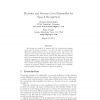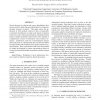118
click to vote
EJASMP
2011
13 years 10 months ago
2011
We address the question of whether and how boosting and bagging can be used for speech recognition. In order to do this, we compare two different boosting schemes, one at the pho...
ICASSP
2011
IEEE
13 years 10 months ago
2011
IEEE
The performance of a speech recognition system may be degraded even without any background noise because of the linear or non-linear distortions incurred by recording devices or r...
ICASSP
2011
IEEE
13 years 10 months ago
2011
IEEE
Phoneme posterior probabilities estimated using Multi-Layer Perceptrons (MLPs) are extensively used both as acoustic scores and features for speech recognition. In this paper we e...
ICASSP
2011
IEEE
13 years 10 months ago
2011
IEEE
The acceleration of acoustic likelihood calculation has been an important research issue for developing practical speech recognition systems. And there are various specification ...
ICASSP
2011
IEEE
13 years 10 months ago
2011
IEEE
Local business voice search is a popular application for mobile phones, where hands-free interaction and speed are critical to users. However, speech recognition accuracy is still...
ICASSP
2011
IEEE
13 years 10 months ago
2011
IEEE
Previously we have proposed different models for estimating articulatory gestures and vocal tract variable (TV) trajectories from synthetic speech. We have shown that when deploye...
ICASSP
2011
IEEE
13 years 10 months ago
2011
IEEE
This paper presents a new approach to estimate “universal” phoneme posterior probabilities for mixed language speech recognition. More specifically, we propose a new theoreti...
ICASSP
2011
IEEE
13 years 10 months ago
2011
IEEE
Recent advances in coherent and convex demodulation have proven useful for analyzing and modifying the low-frequency envelope structure of speech. This paper reports the applicati...
ICASSP
2011
IEEE
13 years 10 months ago
2011
IEEE
Speech recognition applications are known to require a significant amount of resources (memory, computing power). However, embedded speech recognition systems, such as in mobile p...
ICASSP
2011
IEEE
13 years 10 months ago
2011
IEEE
Recently there has been interest in structured discriminative models for speech recognition. In these models sentence posteriors are directly modelled, given a set of features ext...






